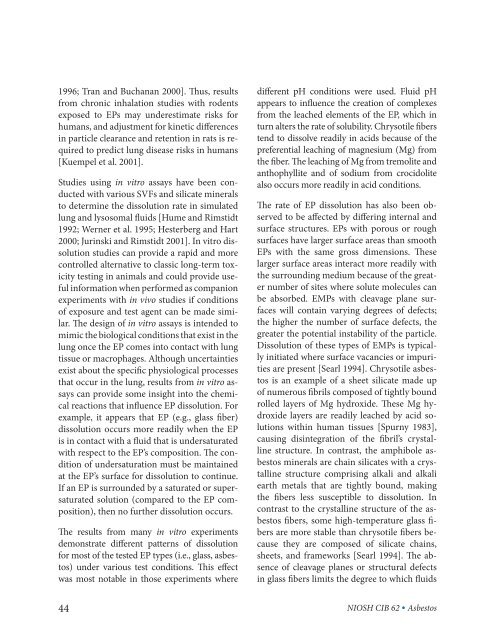Asbestos Fibers and Other Elongate Mineral Particles: State of the ...
Asbestos Fibers and Other Elongate Mineral Particles: State of the ...
Asbestos Fibers and Other Elongate Mineral Particles: State of the ...
- No tags were found...
Create successful ePaper yourself
Turn your PDF publications into a flip-book with our unique Google optimized e-Paper software.
1996; Tran <strong>and</strong> Buchanan 2000]. Thus, results<br />
from chronic inhalation studies with rodents<br />
exposed to EPs may underestimate risks for<br />
humans, <strong>and</strong> adjustment for kinetic differences<br />
in particle clearance <strong>and</strong> retention in rats is required<br />
to predict lung disease risks in humans<br />
[Kuempel et al. 2001].<br />
Studies using in vitro assays have been conducted<br />
with various SVFs <strong>and</strong> silicate minerals<br />
to determine <strong>the</strong> dissolution rate in simulated<br />
lung <strong>and</strong> lysosomal fluids [Hume <strong>and</strong> Rimstidt<br />
1992; Werner et al. 1995; Hesterberg <strong>and</strong> Hart<br />
2000; Jurinski <strong>and</strong> Rimstidt 2001]. In vitro dissolution<br />
studies can provide a rapid <strong>and</strong> more<br />
controlled alternative to classic long-term toxicity<br />
testing in animals <strong>and</strong> could provide useful<br />
information when performed as companion<br />
experiments with in vivo studies if conditions<br />
<strong>of</strong> exposure <strong>and</strong> test agent can be made similar.<br />
The design <strong>of</strong> in vitro assays is intended to<br />
mimic <strong>the</strong> biological conditions that exist in <strong>the</strong><br />
lung once <strong>the</strong> EP comes into contact with lung<br />
tissue or macrophages. Although uncertainties<br />
exist about <strong>the</strong> specific physiological processes<br />
that occur in <strong>the</strong> lung, results from in vitro assays<br />
can provide some insight into <strong>the</strong> chemical<br />
reactions that influence EP dissolution. For<br />
example, it appears that EP (e.g., glass fiber)<br />
dissolution occurs more readily when <strong>the</strong> EP<br />
is in contact with a fluid that is undersaturated<br />
with respect to <strong>the</strong> EP’s composition. The condition<br />
<strong>of</strong> undersaturation must be maintained<br />
at <strong>the</strong> EP’s surface for dissolution to continue.<br />
If an EP is surrounded by a saturated or supersaturated<br />
solution (compared to <strong>the</strong> EP composition),<br />
<strong>the</strong>n no fur<strong>the</strong>r dissolution occurs.<br />
The results from many in vitro experiments<br />
demonstrate different patterns <strong>of</strong> dissolution<br />
for most <strong>of</strong> <strong>the</strong> tested EP types (i.e., glass, asbestos)<br />
under various test conditions. This effect<br />
was most notable in those experiments where<br />
44<br />
different pH conditions were used. Fluid pH<br />
appears to influence <strong>the</strong> creation <strong>of</strong> complexes<br />
from <strong>the</strong> leached elements <strong>of</strong> <strong>the</strong> EP, which in<br />
turn alters <strong>the</strong> rate <strong>of</strong> solubility. Chrysotile fibers<br />
tend to dissolve readily in acids because <strong>of</strong> <strong>the</strong><br />
preferential leaching <strong>of</strong> magnesium (Mg) from<br />
<strong>the</strong> fiber. The leaching <strong>of</strong> Mg from tremolite <strong>and</strong><br />
anthophyllite <strong>and</strong> <strong>of</strong> sodium from crocidolite<br />
also occurs more readily in acid conditions.<br />
The rate <strong>of</strong> EP dissolution has also been observed<br />
to be affected by differing internal <strong>and</strong><br />
surface structures. EPs with porous or rough<br />
surfaces have larger surface areas than smooth<br />
EPs with <strong>the</strong> same gross dimensions. These<br />
larger surface areas interact more readily with<br />
<strong>the</strong> surrounding medium because <strong>of</strong> <strong>the</strong> greater<br />
number <strong>of</strong> sites where solute molecules can<br />
be absorbed. EMPs with cleavage plane surfaces<br />
will contain varying degrees <strong>of</strong> defects;<br />
<strong>the</strong> higher <strong>the</strong> number <strong>of</strong> surface defects, <strong>the</strong><br />
greater <strong>the</strong> potential instability <strong>of</strong> <strong>the</strong> particle.<br />
Dissolution <strong>of</strong> <strong>the</strong>se types <strong>of</strong> EMPs is typically<br />
initiated where surface vacancies or impurities<br />
are present [Searl 1994]. Chrysotile asbestos<br />
is an example <strong>of</strong> a sheet silicate made up<br />
<strong>of</strong> numerous fibrils composed <strong>of</strong> tightly bound<br />
rolled layers <strong>of</strong> Mg hydroxide. These Mg hydroxide<br />
layers are readily leached by acid solutions<br />
within human tissues [Spurny 1983],<br />
causing disintegration <strong>of</strong> <strong>the</strong> fibril’s crystalline<br />
structure. In contrast, <strong>the</strong> amphibole asbestos<br />
minerals are chain silicates with a crystalline<br />
structure comprising alkali <strong>and</strong> alkali<br />
earth metals that are tightly bound, making<br />
<strong>the</strong> fibers less susceptible to dissolution. In<br />
contrast to <strong>the</strong> crystalline structure <strong>of</strong> <strong>the</strong> asbestos<br />
fibers, some high-temperature glass fibers<br />
are more stable than chrysotile fibers because<br />
<strong>the</strong>y are composed <strong>of</strong> silicate chains,<br />
sheets, <strong>and</strong> frameworks [Searl 1994]. The absence<br />
<strong>of</strong> cleavage planes or structural defects<br />
in glass fibers limits <strong>the</strong> degree to which fluids<br />
NIOSH CIB 62 • <strong>Asbestos</strong>

















